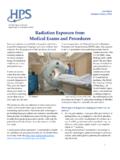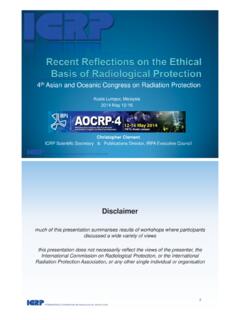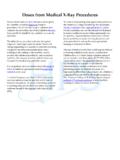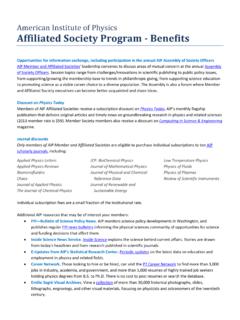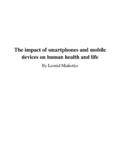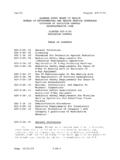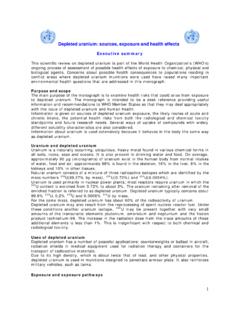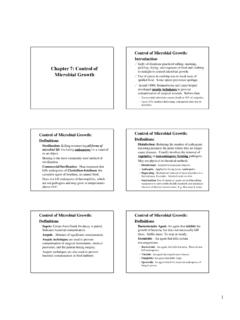Transcription of Background Radiation Fact Sheet - Health Physics …
1 1 Health Physics Society Specialists in Radiation Safety Background Radiation fact Sheet Adopted: June 2012 Revised: June 2015 Sources of Background Radiation Background Radiation is emitted from both natural and human-made radionuclides. Some naturally occurring Radiation comes from the atmosphere as a result of radi-ation from outer space, some comes from the earth, and some is even in our bodies as a result of radionuclides in the food and water we ingest and the air we breathe. Additionally, human-made Radiation enters our envi-ronment from con-sumer products, ac-tivities such as medi-cal procedures, and nuclear power plants. The largest source of human-made Radiation expo-sure or dose is from medical testing and treatment (NCRP 2009). Figure 1 depicts the typical distribution of exposure from all sources of back-ground Radiation .
2 As can be seen, natural Background radia-tion is the largest source of Radiation exposure to humans (50 percent). However, medical sources of Radiation exposure are almost as large (48 percent). The remaining 2 percent comes from consumer products, occupational exposure, and industrial expo-sure, which includes the exposure from nuclear power plants. Each of these sources is discussed below. Radionuclides in the Body Terrestrial and cosmogenic radionuclides enter the body through the food we eat, the water we drink, and the air we breathe. The most significant radionuclides that en-ter the body are ter-restrial in origin. Pri-mary among them is radon gas (and its de-cay products) that we constantly inhale (Figure 2). Radon levels depend on the uranium and thori-um content of the soil, which varies widely across the United States.
3 Other radionuclides in the body include uranium and thori-um and their decay products, as well as potassium-40. These terrestrial radionu-clides are in the soil, subsequently being incorporated into our food and wa-ter supply. Most drinking-water sources have very low levels of terrestrial radionuclides, including radium-226, *Words in italics are defined in the Glossary on page 3. Background Radiation surrounds us at all times it is everywhere. Since the earth was formed and life developed, all life on earth has been exposed to ionizing Radiation *. This fact Sheet addresses the baseline sources of back-ground ionizing Radiation . Figure 1: Source Distribution for all Radiation Dose Percent contribution of various sources of exposure to the total dose per individual in the popula-tion for 2006 (Figure from NCRP 160), reprinted with permission of the Na-tional Council on Radiation Protection and Measurements, 2 radium-228, and uranium.
4 These radionuclides may be higher in some areas of the United States than in others. Typically these levels are less than the drinking-water standards established by the United States Environmen-tal Protection The average dose from all inhaled radionuclides is about mSv (millisieverts) per year, which is about 73 percent of the average total dose from Background radi-ation. The average dose from all ingested radionuclides is about mSv per year. This is about 9 per-cent of the average total dose from Background Radiation . Radiation From Space Radiation from outer space is called cosmic ra-diation. Radiation from beyond the solar system has enough energy to generate additional radia-tion and cosmogenic radi-onuclides as it passes through the earth s at-mosphere. Some of this Radiation reaches the earth s surface, with most entering near the poles, where shielding by the earth s magnetic field is the weakest, and at high altitudes, where the earth s at-mosphere is the thinnest.
5 Cosmogenic radionuclides con-sist primarily of tritium (hydrogen-3), carbon-14, and be-ryllium-7. In the United States, the average dose from space Radiation is about Sv in an hour, or about mSv each year. This dose varies and depends on the lati-tude and altitude where a person lives. The average space Radiation dose makes up about 11 percent of the average total dose from Background Radiation (see Resources listed at the end of this fact Sheet for more information). Radionuclides Originating on Earth Radiation that originates on earth is called terrestrial Radiation . Radionuclides that were present when the earth formed are referred to as primordial. They are found around the globe in sedimentary and igneous rock. From rocks, these radionuclides migrate into soil, water, and even the air.
6 Human activities such as urani-um mining have also redistributed some of these radio-nuclides (for more information, see the Health Physics Society Uranium fact Sheet2). Primordial radionu-clides include the series of radionuclides produced when uranium and thorium decay, as well as potassi-um-40 and rubidium-87. In the United States, the aver-age dose from terrestrial Radiation (not including the dose from ingested and inhaled radionu-clides) is about Sv in an hour, for about mSv per year. The dose from terrestrial Radiation also varies with location: doses on the Atlantic and Gulf coastal plains are lowest, while those in the mountains of the western United States are highest. The average terrestrial Radiation dose (not in-cluding the dose from radionuclides in the body, discussed below) is about 7 percent of the average total dose from Background Radiation (see Resources listed at the end of this fact Sheet for more information).
7 Human-Made Sources of Radiation By far, the major source of human-made Radiation is from medical applications. The medical exposure in Fig-ure 1 represents the total exposure for medical proce-dures averaged over the entire population. The in-crease in the medical use of Radiation accounts for the largest part of the overall increase in Radiation exposure over the last several years. However, like natural back-ground Radiation , this dose is not evenly distributed across the population. People with Health issues receive the majority of the dose, especially older individuals. 1 2 Figure 2: Source Distribution of Ubiquitous Background Dose Dis-tribution of the population dose among the various sources of back-ground Radiation (Figure 3-19 from NCRP 160); reprinted with permis-sion of the National Council on Radiation Protection and Measure-ments, 3 Much of the increase in Radiation from medical applica-tions is due to advances in technology, especially the increased use of computed tomography (CT).
8 As illus-trated in Figure 1, CT scans are the major medical source of Radiation and account for half of the medical exposure (for more information, see the Health Physics Society Radiation Exposure from Medical Exams and Proce-dures fact Sheet3). Other sources of Radiation include consumer products and uses of natural radioactivity, such as in some smoke detectors, energy-saving compact fluorescent light bulbs, timepieces, ceramics, fertilizers, and lantern man-tles (for more information, see the Health Physics Socie-ty Consumer Products Containing Radioactive Materi-als fact Sheet4). Medical doses have increased to the point that by 2006 the average dose was about 3 mSv per year, al-most half of all exposure. Since the 1980s, there has been more than a three-fold increase, resulting in an increased concern by the medical community and efforts to make sure that these exposures to Radiation are medically justified.
9 As illustrated in Figure 1, the use of CT scans is the major medical source of radia-tion and accounts for half of the medical exposure. Other consumer products and occupational and in-dustrial exposure, which includes the exposure from the operation of nuclear power plants, only contrib-ute about mSv per year (2 percent of the expo-sure). Total Average Dose from Background Radiation Each year, residents of the United States receive an aver-age dose from natural Background Radiation of about mSv. The various source components of this dose are shown in Figure 2 and discussed later. This figure does not include man-made doses, such as from medical pro-cedures, which add about another mSv for a total of about mSv per year. Glossary This fact Sheet may use nuclear terms that are unfamiliar.
10 Many of these are denoted in italics in the text and are defined in this glossary. More can be found on the Radiation Terms and Definitions page on the Health Physics So-ciety website at Cosmogenic Radionuclides Radionuclides produced in the atmosphere by cosmic Radiation interacting with molecules. Decay (Radioactive Decay) The decrease in the amount of any radioactive material with the passage of time due to the spontaneous emission from the nuclei of either alpha or beta particles, often accompanied by gamma Radiation . Radioactive material de-cays with a half-life that is specific to that particular substance. The half-life is the time in which one-half of the radi-oactive material decays through spontaneous emissions. Dose ( Radiation Dose) Refers to the effect on a material that is exposed to Radiation .

